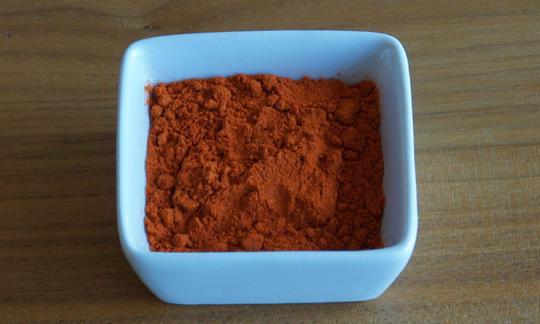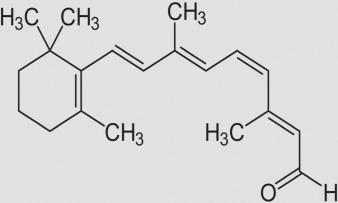Table of contents
Paprika powder, sweet, is a fine, red powder ( organic ) with a fruity-sweet to mildly spicy taste. It consists of dried, ground red peppers (often from the red pointed pepper, Capsicum annuum L.).
Use in the kitchen
What is paprika powder? The spice paprika, sweet, is a fine powder that is obtained by grinding dried peppers (or spice paprikas). Many raw peppers have an elongated, tapered shape, a fiery red color and are more delicate than sweet peppers (red) .
Paprika powder is one of the most popular spices in the world. In Arabic, Turkish and Indian cuisine, this spice is an important component in many dishes - as well as in Hungary, Spain and Portugal. Paprika powder is often referred to as Hungarian paprika powder. The barely perceptible spiciness of the paprika powder goes well with both hot and cold dishes. The paprika spice (sweet) is sweet and mild and only slightly spicy in taste because the spicy components are removed from the peppers before processing.
Sweet paprika powder can be used to refine stews such as vegan goulash or chili sin carne, but also soups, sauces (tomato sauces), dips, casseroles, falafel, patties, potatoes or various vegetable, rice or pasta dishes. Paprika powder is an integral component in spice mixtures (such as barbecue spice, "China spice", curry) or spice pastes. The fine powder is often used to color sauces, spreads or as a decoration due to its bright red color.
For a more intense flavor, you can fry sweet paprika briefly and gently in a little oil over a low heat. Make sure the fat is not too hot, otherwise the reddish powder will taste bitter and lose its flavor, color and ingredients.
Is paprika powder hot? In addition to mild paprika powder (= sweet), there are other types of paprika powder. The red paprika powder from Hungary is divided into different grades, depending on spiciness, aroma and color intensity: 11,12
- The hottest paprika powder is called hot, its color ranges from yellowish to reddish brown (high proportion of pericarp, placenta and seeds). 20
- With 100-500 Scoville units, rose paprika powder is also hot in taste, but has an aromatic note. The color is dark red to yellowish light red. In the hot varieties, a large part of the seeds and placental tissue is contained in the powder.
- Semi-sweet paprika powder tastes hot with 10-50 Scoville units, with a good aromatic taste. The color is classified as dull red to yellowish red.
- With 0-10 Scoville units, the bright red sweet paprika powder is mild, sweet and fruity to slightly spicy (spicy).
- Delicatessen paprika powder is bright red to dark red and has a mild, aromatic taste. It contains neither seeds nor capsaicin-containing placental tissue, so it has 0 Scoville and a high coloring content. Sometimes advertised as the "best paprika powder."
The classification varies greatly depending on the region. In addition to the well-known Hungarian paprika powder, there is also Spanish paprika powder (pimentón), which is available in mild (pimentón dulce), mild spicy (pimentón agridulce) and hot (pimentón picante). There is also smoked paprika powder from the Spanish region "La Vera": Pimentón de la Vera .
A much hotter powder is cayenne pepper, ground from the dried, hot fruits of the cayenne chili variety. Chili powder, on the other hand, is a mixture of cayenne pepper, cumin, garlic and oregano (among other things).
Homemade
Paprika powder is easy to make yourself: When making paprika spices, you use the leftovers from slightly wilted or soft raw peppers, other vegetables and herbs. Freshly ground spices taste more intense and aromatic than store-bought ones, and at the same time you can keep an eye on the raw food temperature. However, you have to expect that the grinding degree will not be as fine as with store-bought paprika powder. Making paprika powder takes some time, as fresh vegetables have to dry for several hours.
For pure paprika powder, you can use spiced peppers, e.g. pointed peppers or chili peppers, but also leftover red bell peppers (raw) . Depending on the desired spiciness, the placental tissue and the seeds are also used for the paprika seasoning. For the traditional paprika powder from Hungary, Füszerpaprika (e.g. Kalocsai, Csipös or Edes) is usually used. Here too, the degree of spiciness varies. In addition to being used as a powder, these pointed peppers are also suitable as raw food, for cooking, pickling and grilling. 9
To make powder from raw paprika, wash the peppers used and dry them well. For 100 g of paprika spice, you need about 1 kg of fresh peppers. First, halve, core and cut the raw peppers into strips and dry them in the dehydrator on the setting provided (about 40 °C) or in the oven at 40-50 °C (fan oven). In order to preserve as many vitamins as possible, gentle drying at low temperatures is particularly important (raw food quality). The pepper strips should not be placed on top of each other, but next to each other on a rack or grill (oven). In the oven, leave the oven door slightly open so that the moisture can escape. Turn the peppers from time to time until they are completely dried. The process can take between 8 and 12 hours, depending on the thickness of the peppers and the temperature. Completely dried peppers can be broken up by hand. After drying, you can pulverize the peppers in a blender, coffee grinder or with a mortar. Dried herbs (e.g. oregano, basil, thyme ) give the powder an excellent taste. For a longer shelf life, you can also add 1-2 pinches of salt. If you then sieve the powder, you can use the coarser particles as paprika flakes for seasoning. 1
Vegan recipe for noodles (pasta) in paprika sauce
Ingredients (for 2 people): 250 g pasta (e.g. spaghetti, penne, fusilli), 120 ml plant milk (e.g. oat milk ), 2 red bell peppers (raw), 3 tbsp almond butter (organic), 3 tbsp yeast flakes, 2 tbsp tomato paste, 3 cloves of garlic, 1 onion, 1 tbsp Hungarian paprika powder, sweet (organic) and a pinch of salt .
Preparation: First, preheat the oven to 180 °C top and bottom heat. Peel and quarter the onion, peel the garlic and leave it whole. Halve and deseed the washed peppers and cut them into strips. Spread the onion, garlic and pepper on a baking tray and cook in the oven for 20-30 minutes. In the meantime, cook the pasta until al dente. Puree the roasted vegetables together with plant milk, yeast flakes, almond paste, tomato paste, salt and paprika powder using a hand blender to make a creamy sauce. Pour the vegan paprika sauce into a deep pan and simmer for 10 minutes. Add the cooked pasta, mix well, divide between two plates and decorate with fresh basil leaves .
Vegan recipes with sweet paprika powder can be found under the note: " Recipes that use the most of this ingredient ".
| Not only vegans or vegetarians should read this: Vegans often eat unhealthily. Avoidable nutritional errors . |
Purchasing - Storage
Sweet paprika powder is one of the basic spices and is available in all supermarkets such as Coop , Migros , Denner , Volg , Spar , Aldi , Lidl , Rewe , Edeka , Hofer , Billa etc. You can find it under the following names: ground sweet paprika, delicatessen paprika powder, sweet paprika etc. Occasionally even large retailers stock sweet paprika powder in organic quality; in any case you can find it in organic shops, organic supermarkets ( Denn's Biomarkt and Alnatura ), health food stores, drugstores or delicatessens (delicatessens). You can also buy the mildly sweet paprika spice organically produced (organic) on the Internet. If no organic product is available, you should at least look for fair trade (e.g. Fairtrade ).
It is difficult to verify whether purchased products can still be described as raw food or raw 21 - even with sun-dried peppers. In general, the term "raw food" is not subject to any controls and is associated with a great deal of trust in the producers. Very high temperatures can also be created in the sun. Recently, producers have been advertising with the label sun-dried or solar-dried (gently sun-dried/solar-dried), but even then raw food temperatures are not necessarily guaranteed. 22
It is worth making your own paprika powder to ensure that it is dried as gently as possible. Then you are sure to have raw food quality (raw).
The availability of sweet paprika powder varies depending on the size of the store, catchment area, etc. You can find our recorded food prices for the DA-CH countries above under the ingredient image - and by clicking you can see their development at various suppliers.
Storage tips
Spices such as sweet paprika powder can be kept for up to 3 years if well sealed in opaque containers. Once opened, they should be used within 6 months. Store paprika powder in small quantities and in a dry, cool, airtight place, protected from light. If stored incorrectly, red paprika powder can turn yellowish-brown and the essential oils responsible for the aroma evaporate. The smell tells you whether the paprika powder still has a good flavor. If the paprika powder is sticky, it must be thrown away. 2
Ingredients - Nutritional values - Calories
Here we realistically show you the ingredients of spices and herbs per 1 g (instead of per 100 g as usual).
1 g of sweet paprika powder contains hardly any fat (0.13 g) and protein (0.15 g). The energy content per 1 g is 3.57 kcal. This includes the sugar content. Over half of the fine powder consists of carbohydrates (0.56 g/1g), of which 0.33 g is sugar and 0.21 g isfiber . 3
Vitamin A, as RAE , Iron andriboflavin (vitamin B2 ) are the most important essential nutrients that sweet paprika powder offers. However, because of the small amount consumed, they and the macronutrients do not contribute significantly to meeting the respective daily requirement. Far more important for the health value are the secondary plant substances in this ingredient, which can have an effect even in trace amounts. Although all herbs and spices have many health-promoting ingredients, we deliberately avoid the insubstantial buzzword "superfood" here.
Especially in the case of industrial products, the nutrient composition can vary greatly depending on the manufacturer.
The complete ingredients of paprika powder (sweet), the coverage of the daily requirement and comparison values with other ingredients can be found in our nutrient tables. In the article Nutrients explained you will get a detailed insight into the topic.
Health effects
Is paprika powder healthy? The fact that paprika spice is healthy is shown by the high concentration of vitamins, minerals and secondary plant substances. In particular, vitamin B6, which is contained in both paprika and paprika spice, contributes to the body's protein metabolism, cell division and nervous system and relieves PMS and morning sickness. 30 Compared to paprika, paprika spice contains higher amounts of B-complex vitamins, vitamins E, A and K as well as minerals such as iron, zinc, copper, magnesium, phosphorus, potassium and calcium. 31 Paprika spice has antioxidant properties, supports the immune system, nervous system and muscles and even promotes healthy bones, skin and hair. 30
Secondary plant substances
Many of the health effects of sweet paprika powder can be attributed to the secondary plant substances it contains. Our article on secondary plant substances provides an overview of the classification of substance groups, their occurrence in foods and possible effects on humans. Paprika powder contains the following secondary plant substances, among others: 17, 28
- Isoprenoids : Carotenoids (β-carotene, capsanthin, capsorubin, lutein)
- Polyphenols : flavonoids
- Alkaloids : Capsaicin 29
However, it should be noted that the composition of the secondary plant substances in the paprika powder can vary depending on the time of harvest and growing conditions. Therefore, quantities are only of limited use and should only be understood roughly.
Paprika also has a high concentration of provitamin A. β-carotene acts as a precursor to provitamin A. The secondary plant substances contained in red pepper, which also include carotenoids and flavonoids, have an antioxidant effect in the body. Carotenoids are said to "catch" free radicals and thus reduce oxidative stress. 16 Flavonoids have an anti-inflammatory effect. 5 The red pigments capsanthin, capsorubin and lutein are also known as antioxidants, which are said to protect against UV light. 17
Sweet paprika powder contains small amounts of the secondary plant substance capsaicin, which is responsible for the spiciness of the peppers. Capsaicin has an anti-inflammatory effect, stimulates the appetite, improves circulation and aids digestion, but in very large amounts it can irritate the skin and stomach lining. Paprika powder also contains large amounts of essential oils and fiber. Fiber also stimulates digestion and counteracts constipation. 4
Dangers - Intolerances - Side effects
Is paprika powder harmful to health? If you suffer from a (rare) allergy to nightshades (including potatoes, eggplants, tomatoes, cape gooseberries, tobacco, chili, peppers, etc.), you may also react to paprika powder. A food allergy to nightshades causes hives and swelling in the face, mouth and throat. Food intolerances to nightshades can also occur, and these often manifest themselves in the form of flatulence and cramps. 6
Some people who are allergic to pollen (e.g. birch, grass or grain) 6 can also have allergic reactions to peppers. Cross-reactions to mugwort pollen or goosefoot pollen are also possible. 7 Both pollen and peppers (raw) contain allergens with identical or very similar structures. Symptoms include burning in the mouth, swelling and numbness of the tongue and lips, swelling in the larynx area and even shortness of breath. 8
Paprika powder is very susceptible to counterfeiting, known as "food fraud". In addition to brick dust, rice flour, bran and sawdust were also found in paprika powder. In 2003, investigations showed that the toxic, possibly carcinogenic solvent dye "Sudan red" was contained in certain paprika powders. 18 A rust inhibitor (red lead, lead(II,IV) oxide) also led to mass poisonings in Hungary in 1994. Aflatoxins and ochratoxin are poisons that have been found in spices such as paprika, chili pepper and nutmeg . 19
Is too much paprika powder unhealthy? Conventional peppers and products made from them (such as paprika powder) can contain large amounts of pesticide residues, which can potentially be harmful to health. Imported goods from Thailand and Vietnam have the highest levels of pesticide residues, but Turkish, Spanish and Moroccan peppers and pepper products also have high levels of residues. Organic peppers and organic paprika spices have significantly less pesticide residues. 13
Ecological footprint - animal welfare
The ecological footprint of a food depends on various factors. The type of agricultural production (conventional vs. organic), seasonal, regional or domestic production or import by truck, ship or plane, different types of packaging and whether the goods are fresh or frozen all play a decisive role. 26
One kg of bell peppers has a CO 2 footprint of around 0.6 kg CO 2 eq/kg. 26 For chili peppers, the value (2024) is slightly higher at 0.96 kg CO 2 eq/kg (2021: 1.02 kg CO 2 eq/kg). 27 ETH Zurich has measured the global biodiversity loss due to land occupation of the products that are most commonly consumed in Switzerland. These include bell peppers (peppers) and chili peppers. Products from Sri Lanka are striking, with a biodiversity loss of 2.47 gPDF-eq per kg, compared to chilies and peppers from Spain, whose value is 0.05 gPDF-eq per kg. 24
The water footprint for 1 kg of green chilies and peppers is a total of 379 litres. This means that chilies are above the global average water consumption for vegetables (322 l/kg). 25
In general, fresh, unpackaged, seasonal and regional vegetables have the lowest emissions. The more a food is processed, the worse its ecological footprint is. This is why paprika powder tends to have a worse CO2 balance.
For detailed explanations of various sustainability indicators (such as ecological footprint, CO2 footprint, water footprint), see our article: What does the ecological footprint mean?
Worldwide occurrence - cultivation
The origin of the Capsicum species, which have developed in different regions, is probably in Central and South America (Andes). 10 7000 years ago, wild forms were used as a dye, currency, spice and medicine. In the 16th century, the paprika plant came to Europe via Turkey. Cultivated milder varieties were used as a pepper substitute, hence the name "Turkish pepper". From the 18th century, paprika was very popular as a spice in Hungary, Spain and among the Ottomans. 11 Paprika powder (sweet) gained importance in the 19th century through the French chef Auguste Escoffier . He introduced Hungary's national spice into French haute cuisine. 12
Today, paprika powder is mainly produced in Hungary, Bulgaria, Spain, Greece and Turkey. You can read detailed information about growing and harvesting bell peppers in the article on red sweet peppers .
Industrial production
How do you make powder from paprika? To make sweet paprika powder, you first have to wash and dry the peppers. The traditional method involves stringing the peppers on strings to avoid bruising and drying the fruit in the sun. Hanging them in drag nets or laying them out on drying floors is also possible. Here you have to make sure that you turn them regularly. After around 4-6 weeks in the sun, the peppers are completely dry. Other options are drying chambers and drying trays. The temperatures are often 50-60 °C. The temperatures on mechanical conveyor belts start at 100 °C and then drop to 72 °C for around 5 hours in storage chambers. 21 Industrially produced paprika powder is therefore no longer considered raw. In Hungary, the dried pepper parts are traditionally ground in stone mills to different degrees of grinding (coarse to very fine). The industry also uses hammer mills.
Depending on the desired spiciness, more or fewer septa and seeds are included. The septa (placental ridges) have the highest content of hot capsaicin. 14 Since the essential oils (spice-giving components) evaporate easily, grinding must be done very carefully so that the ground material does not heat up too much in the spice mill and lose its aroma. 15 The paprika powder is finally available in stores in spice jars, bags or jars.
Further information
: Peppers belong to the genus Capsicum and the nightshade family (Solanaceae) . Within the species Capsicum annuum, a distinction is made between different groups 10,23 : cherry peppers belong to the Cerasiforme group, cone-shaped peppers to the Conoides, cone-shaped fruits to the Fasciculatum group, sweet peppers to the Grossum group and long, curved fruits such as pointed peppers to the Longum group.
The name "spice peppers" refers to varieties that are well suited for the production of paprika powder (high dry matter, thin pulp). For paprika powder, representatives of the Longum group ( Capsicum annuum ) are mostly used. but not only that. Studies are increasingly investigating which Capsicum species are particularly attractive for the mechanical harvesting of the pods, the industrial production of paprika powder and the final coloring. 23
Alternative names
Paprika spice (ground paprika, paprika powder) is also known under the names Spanish pepper, Indian pepper, Turkish pepper and Hungarian pepper as well as red pepper or biting berry. Less commonly, it is also called peppercorn or spice paprika, which makes it difficult to clearly distinguish between the plant and the peppers.
Outside Switzerland, the following spelling is common in German-speaking countries: Paprikapulver süss. Other incorrect spellings include: Paparika, Paprika Gewürz, Paprika Pulver and Edelsüß Paprika.
In English, sweet paprika powder is called sweet paprika powder or mild paprika. Paprika powder is often called paprika powder, milled paprika, ground paprika or just paprika. Spice paprika (as a powder) is also called spice paprika powder, spice paprika as a plant is sometimes called spice paprika plant or condiment paprika plant.
Bibliography - 31 Sources (Link to the evidence)
| 1. | Smarticular net: Paprikapulver und Chilipulver selber machen zur Resteverwertung. |
| 2. | Ostmann de: Wie lagere ich Gewürze richtig? |
| 3. | USDA United States Department of Agriculture. |
| 4. | Roger JDP. Heilkräfte der Nahrung, Praxishandbuch. Advent-Verlag Zürich. 3. Auflage 2008. |
| 5. | Maleki SJ, Crespo JF, Cabanillas B. Anti-inflammatory effects of flavonoids. Food Chem. 30. November 2019;299:125124. |
| 6. | Gesundu de: Nahrungsmittelallergie auf Nachtschattengewächse. 2019. |
| 7. | Gesundheit gv: Öffentliches Gesundheitsportal Österreichs. Kreuzallergien auf Nahrungsmittel. 2018. |
| 8. | DEBInet Deutsches Ernährungsberatungs- & -informationsnetz. Nahrungsmittelallergien-Pollen. |
| 9. | LZ Direkt: Füszerpaprika. |
| 10. | Brücher H. Tropische Nutzpflanzen. Ursprung, Evolution und Domestikation. Springer Verlag. Berlin. 1976. |
| 11. | Pflanzen-lexikon com: Paprika (Capsicum). |
| 12. | Vom-achterhof de: Paprika: edelsüss oder rosenscharf. 2021. |
| 13. | Pini. U. Das Bio-Food-Handbuch. Ullmann: Hamburg, Potsdam. 2014. |
| 14. | Gewuerzkompanie de: Edelsüsses Paprikapulver, mild fruchtig süsses Aroma. |
| 15. | Gewuerzindustrie de: Die Gewürze und ihre industrielle Veredelung. |
| 16. | Matsufuji H, Nakamura H et al. Antioxidant activity of capsanthin and the fatty acid esters in paprika (Capsicum annuum). J Agric Food Chem. 1998;46(9):3468–72. |
| 17. | Fernández-García E, Carvajal-Lérida I, Pérez-Gálvez A. Carotenoids exclusively synthesized in red pepper (Capsanthin and capsorubin) protect human dermal fibroblasts against UVB induced DNA damage. Photochem Photobiol Sci. 2016;15(9):1204–1211. |
| 18. | BfR Bundesinstitut für Risikobewertung. Farbstoffe Sudan I bis IV in Lebensmitteln. 2003. |
| 19. | Schmid M, Eberle U. Hot Spot Guide Gewürze Nachhaltigkeitsherausforderungen von Gewürzen & Kräutern entlang der Wertschöpfungsketten. Zentrum für nachhaltige Unternehmungsführung. 2020. |
| 20. | Gernot-katzers-spice-pages com: Paprika (Capsicum annuum L.). |
| 21. | Rubinpaprika com: How is Spice Paprika produced? |
| 22. | Aee at: Erneuerbare Energien in der Entwicklungszusammenarbeit. Solare Trocknung. Zeitschrift Erneuerbare Energie 2001 (1). |
| 23. | Derera NF, Nagy N, Hoxha A. Condiment Paprika Research in Australia. Journal of Business Chemistry, Vol. 2, No. 1, 2005. |
| 24. | Zhiyenbek A, Beretta C, Stoessel F, et al. Ökobilanzierung Früchte- und Gemüseproduktion - eine Entscheidungsunterstützung für ökologisches Einkaufen. ETH Zürich. 2016. |
| 25. | Mekonnen MM, Hoekstra AY. The green, blue and grey water footprint of crops and derived crop products. Hydrol. Earth Syst. Sci. 2011;15:1577-1600. |
| 26. | Reinhardt G, Gärtner S, Wagner T. Ökologische Fussabdrücke von Lebensmitteln und Gerichten in Deutschland. Institut für Energie- und Umweltforschung Heidelberg ifeu. 2020:1-22. |
| 27. | Concito. Denmark's green think tank. The big Climate Database. Version 1. Pepper, hot chili, raw. |
| 28. | Vinković T, Gluščić V et al. Phytochemical composition of ground paprika from the eastern Danube region. Poljoprivreda. 2018;24(2):3–12. |
| 29. | Srinivasan K. Biological activities of red pepper (Capsicum annuum) and its pungent principle capsaicin: a review. Crit Rev Food Sci Nutr. 2016;3;56(9):1488–1500. |
| 30. | Allergie de: Basiswissen Ernährung. |
| 31. | FoodStruct. Bell pepper vs. Paprika — Health Impact and Nutrition Comparison. |











Comments